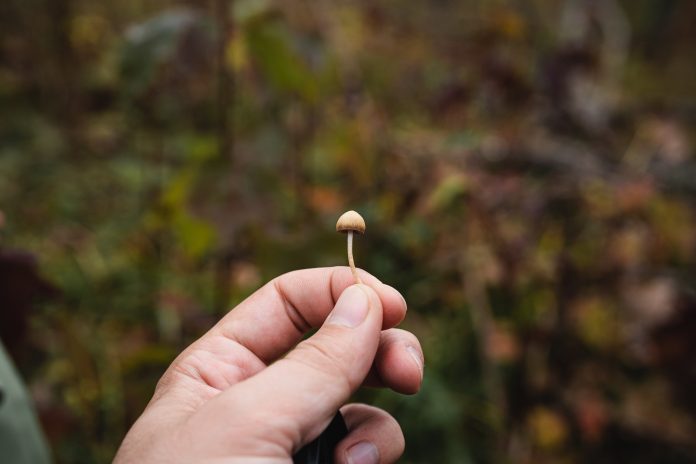While psilocybin reached mainstream consciousness in the psychedelic 1960s, the active element of magic mushrooms has a much longer history.
Magic mushrooms are naturally occurring in great quantity on all the continents of the earth apart from Antarctica.
There is some evidence to suggest that humans have been using magic mushrooms since the birth of civilisation some 9000-12,000 years ago.
Pre 20th century psilocybin
Depending on the historian you ask, you will get a different starting point for when humans began to use magic mushrooms. Some have pointed to rock paintings in Australia dated to 12,000 years B.C that suggest the use of mushrooms.
Others have highlighted paintings in North Africa that date to 9000 B.C that portrays mushroom use.
However, drawing definitive historical conclusions from rock paintings is notoriously difficult and open to interpretation. For this reason, arguing definitively that early civilisations were taking magic mushrooms remains controversial.
Within popular culture, it has become popular to portray the Vikings as keen fans of magic mushrooms whether this be through video games or television shows.
The Vikings are commonly known to have had a vast array of knowledge of the natural world, the plants, and fungi of their land. They were keen foragers and there are many native species of mushrooms in the Scandinavian region.
What they were used for is still largely up for debate. A popular theory is that the Berserker warriors, an elite group of soldiers, used mushrooms to put them into a trance-like state, removing all fear before battle.
One of the active compounds in the Amanita mushroom, native to Scandinavia, is muscimol. This produces a feeling of disinhibition which would support this theory.
Yet recent scholars have poured scorn on this theory, saying that the side effects of drowsiness, vomiting, and muscle spasms would make the Viking Berserkers rather useless in battle.
It is much more likely that if the Vikings did use magic mushrooms then they did so in their religious ceremonies or in their sacrificial ceremonies.
There is some evidence that mushrooms were used in Ancient Greece and Ancient Egypt. Much like the Vikings, the effects of psilocybin seem to have brought the citizens of these ancient places closer to their gods.
Where there is clear evidence that magic mushrooms were used is through the indigenous people of Central America.
Artwork in Central America shows mushrooms as a tool to help the people communicate with the gods. The Mayan and Aztec people had their own word for mushroom which was “Teonanácatl” which when translated means “flesh of the gods.”
The practice was outlawed by when the Spanish conquered the region but still continued through to the modern day in small communities.
The 20th century
Gordon Wasson is largely credited with bringing psychedelic mushrooms into popular culture. It was his article in Life magazine that created the term “magic mushrooms” much to Wasson’s annoyance.
Wasson was travelling through Central America studying mushrooms in 1955 and witnessed and then participated in a ritual ceremony using magic mushrooms along with his wife.
The ceremony was conducted by the Mazatec, an indigenous people who live in Southern Mexico.
Wasson wrote about his experience in an article for Life magazine in 1957 and the editor came up with the title “Seeking the Magic Mushroom”.
Life Magazine at this time was one of the most popular magazines in America with a readership of approximately one quarter of the American population.
After reading the article, Timothy Leary of Harvard University became interested and began conducting studies with them at Harvard.
Leary left Harvard in 1962 but went on to become one of the leading figures of the counter culture that was brewing in 1960’s America. Magic mushrooms and psilocybin became intimately linked with the hippie movement of America.
In 1970, the U.S. government banned the use of magic mushrooms, and it was classed as a schedule I drug which stated that there was “no accepted medical use and a high potential for abuse.”
Although magic mushrooms became illegal there was a large community of people who participated in using them. Unlike other illegal narcotics where they are often man made, mushrooms were easy to find naturally if the person knew where to look.
The psilocybin renaissance
Interest in the possible benefits of psilocybin for psychedelic assisted therapy has been through a revival over the past decade.
Imperial College London completed a study that showed psilocybin performed well as an anti-depressant in a small study. The university had many complications in securing approval to complete the study with psilocybin, including receiving approval from the Home Office and keeping the drug under lock and key with 24 hour surveillance.
However, this study along with several other small studies around the world have paved the way for further research and larger studies.
Australia has recently announced that they are legalising both psilocybin and MDMA for psychedelic assisted therapy. Oregon has announced that they are legalising the drug for sale.


